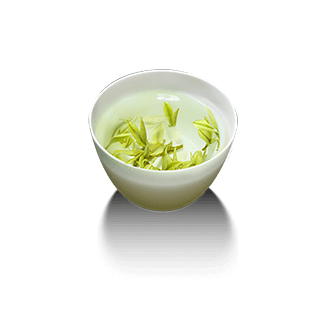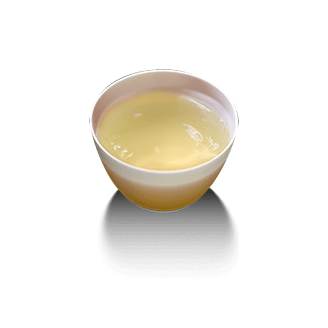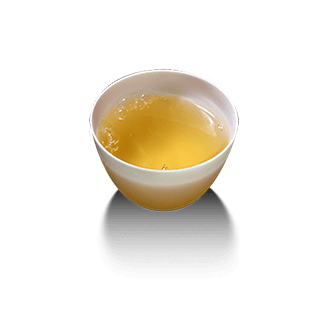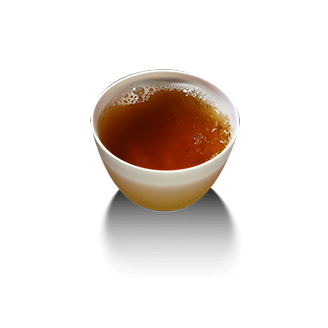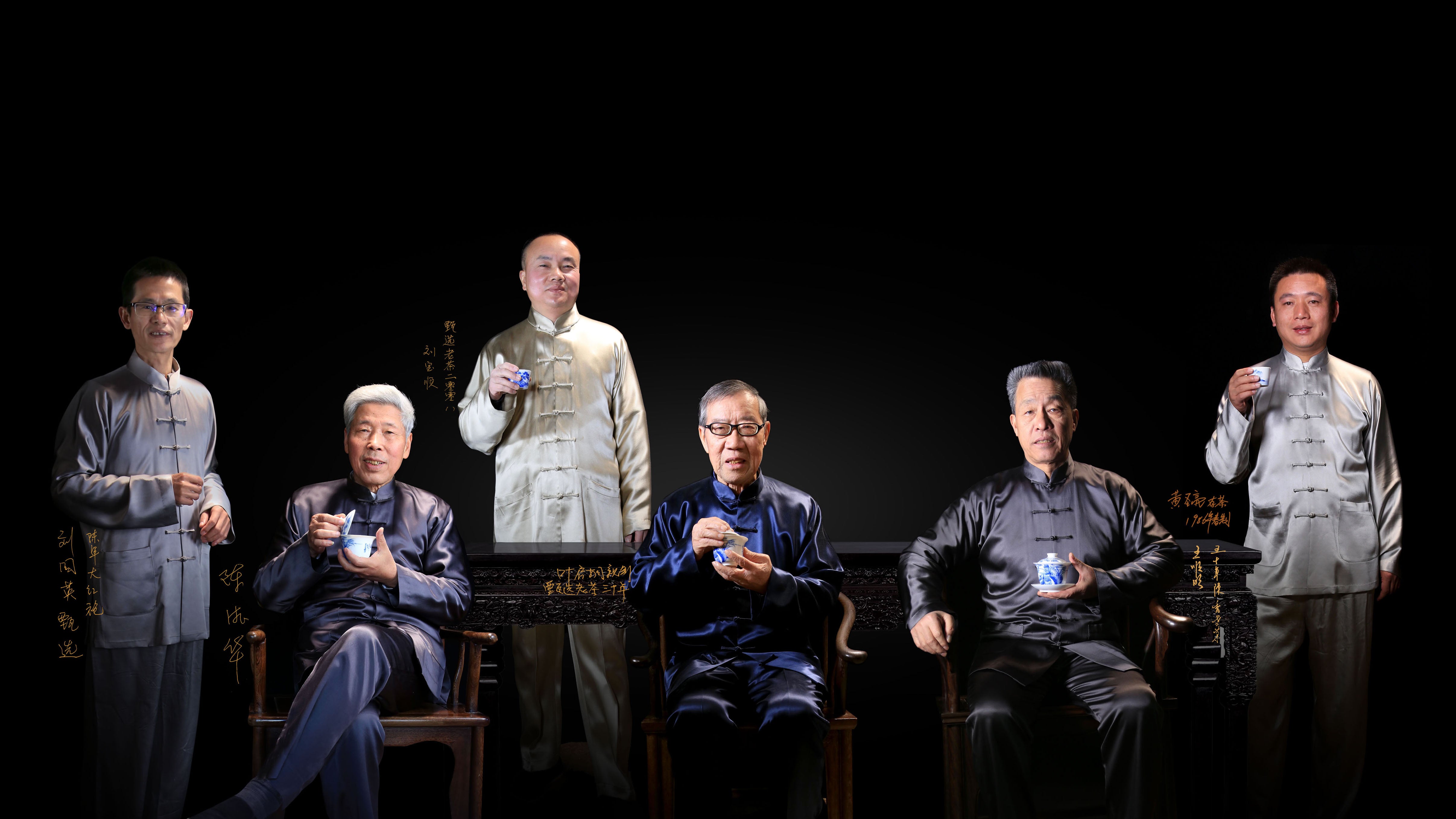

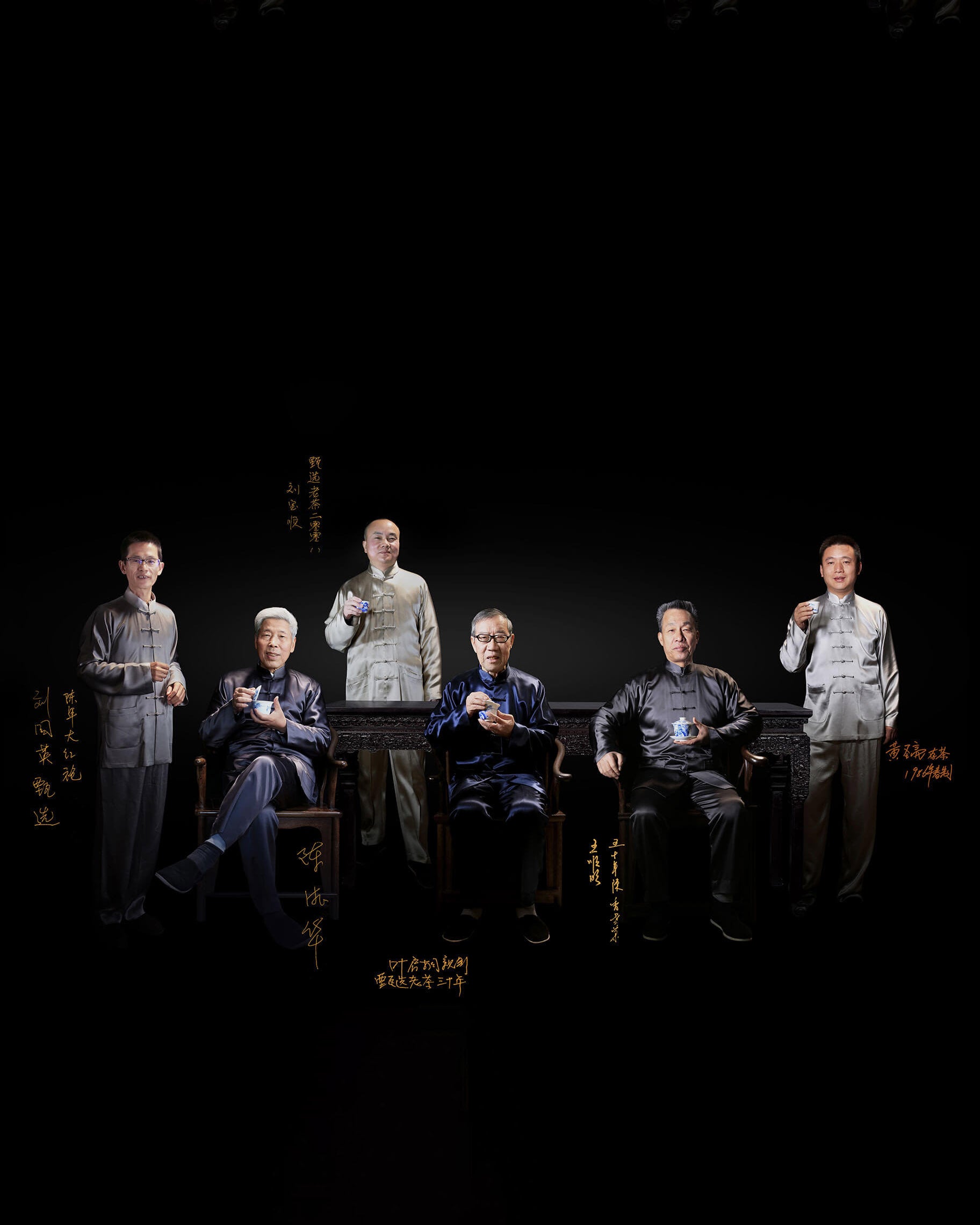
Six Grand Masters Curated Selection Da Hong Pao




Six Grand Masters Curated Selection Da Hong Pao
Ye Qitong:
Veteran Master of Wuyi Rock Tea;
National ICH Heritage Bearer (Wuyi Rock Tea Production Technique);
National Senior Tea Taster;
Twice led the formulation of national standard samples for Wuyi Rock Tea;
proposed the philosophical interpretations: "Rock Bone & Floral Fragrance" and "Rock Rhyme = Unity of Nature and Humanity".
Chen Dehua (1941.8 – 2020.10.8)
Chen Dehua, "The Father of Da Hong Pao";
Former Director of Municipal Tea Research Institute;
Achieved asexual propagation of mother Da Hong Pao trees, bringing imperial-exclusive Da Hong Pao to the public;
National-level ICH Heritage Bearer
Wang Shunming:
Guardian of Mother Da Hong Pao Tea Trees (21 Years);
Leader of Drafting National Standard GB/T18745-2006 (Product of Geographical Indication – Wuyi Rock-essence Tea);
Senior Tea Taster;
National-level ICH Inheritor (Wuyi Rock Tea (Da Hong Pao) Production Technique)
Liu Guoying:
President of Wuyishan Tea Industry Association | Director of Tea Research Institute;
National-level ICH Inheritor (Wuyi Rock Tea (Da Hong Pao) Production Technique);
Tea Science Graduate (Fujian Agricultural College);
Leader of Drafting Local Standard: Brewing and Tasting Methods of Wuyi Rock Tea
Liu Baoshun:
Former Director of Wuyishan Tea Research Institute, and Representative Inheritor of National-level Intangible Cultural Heritage (ICH).
Having dedicated over 30 years to the Tea Research Institute, the "Niurou (Niulan Keng Rougui)" he developed has become a hard currency in the Wuyi rock tea collection circle.
He put forward the technical guidelines of "Making green to full ripeness, roasting to thoroughness" and "Roast thoroughly but not over-high", which solved the industry-wide problem of aged tea preservation.
Huang Shenliang:
Representative Inheritor of the National-level Intangible Cultural Heritage – Traditional Production Technique of Wuyi Rock Tea and Traditional Production Technique of Da Hong Pao.
He is also a hereditary tea maker of the Huang clan.
They are ICH Inheritors representing the pinnacle of Da Hong Pao’s craftsmanship and tea scholarship.
This vintage Da Hong Pao collection is either privately preserved, personally crafted, or carefully selected by six grand masters.
It stands as a cultural symbol of Wuyi Rock Tea.
Each tea boasts either a soaring orchid fragrance or a lingering aged charm—
there is no fixed formula, only distinct artistic styles.
These invaluable rock teas, tempered by time, have developed a more mellow and balanced flavor.
And every tea holds a profound and distant story...

Landscape Holds the Rhyme , Culture Blends into Tea
The cinnabar-red Danxia rock bones of Wuyi, steeped in a thousand years of mist and clouds, nurture the "rock rhyme". Minerals from the broken rock and gravelly soil gently infuse the tea leaves; when the tea touches the palate, it carries the softness of the Jiuqu Stream and the tranquility of Tianyou Peak.
The tea still wraps in the gentle warmth of bygone days. The echoes of the "Mountain-Calling Tea Festival" held at the Spring Equinox, though a century old, linger like soft whispers by the ear. In the Song Dynasty, the Chan monk Chaoquan wrote of "plucking fresh leaves and roasting them to release their fragrance" — the words hold the unhurried rhythm of tea-making that endures to this day. The Ming Dynasty story of a zhuangyuan (top scholar) repaying his gratitude is carved into the stone cliffs of Jiulongke, drifting far and wide with the tea aroma. Even Zhu Xi’s leisurely moments of boiling tea in his academy, and the Chan monks’ tranquil contemplation of "the unity of tea and Zen", have quietly seeped into the tea leaves, becoming the very essence of the tea.
The tea, wrapped in a red sandalwood box, is like tucking away a quiet old scroll.
The new tea, with its rocky bone and floral fragrance, refreshes the heart and spleen; the aged tea slowly matures, retaining the warmth of time and a lingering sweet aftertaste.
Within it lies the master craftsmen’s ingenuity: the mastery of "making green according to the weather" and "making green according to the tea leaves’ state".
Sip it, and it is mellow and silky; store it, and it gains the aged flavor of time.
A tea gift is an implicit cultural expression, a sentiment that needs no words — it also holds the spiritual charm of mountains and rivers, and the warmth of a thousand years of cultural context..
Ye Qitong, National ICH inheritor presented
Vintage 1991 Da Hong Pao
Appreciation
Aged Aroma, Timeless Craftsmanship
Appreciation of Ye Qitong's 1991 Plum Aroma Da Hong Pao: In the world of Wuyi rock tea collecting,the encounter between vintage years and master craftsmanship often forges legends. The 1991 Plum Aroma Da Hong Pao is such a tea – it not only bears the weight of nearly 40 years of time-honored aging, but also, thanks to the personal involvement and high praise of Mr. Ye Qitong, National ICH inheritor, it has become a "timeless treasure" among collectors and tea connoisseurs.
This aged tea, specially preserved by Mr. Ye and cherished by Daya Hall, breaks the one-sided notion that "older tea is inherently more valuable for prolonged storage". With its core traits of "clean purity and mellow smoothness", it perfectly embodies the philosophy: "Quality as the foundation, craftsmanship as the soul, and time as the lingering charm".
Vintage : 1991
Grade : Premium Grade
Supervisor : Ye Qitong, National ICH inheritor of Wuyi Rock Tea (Da Hong Pao) Production Craft
Origin : Core Zheng Yan Production Area, Wuyi Mountain
Variety : Da Hong Pao
I. Background: Craftsmanship as the foundation, time as the witness
When it comes to the significance of this tea, the foremost elements are the "people" and "fate" behind it. Mr. Ye Qitong, a representative inheritor of the Wuyi rock tea making craftsmanship, has dedicated himself to the field of rock tea for decades. His selection of raw materials and control over craftsmanship have long become industry benchmarks.
In 1991, Mr. Ye personally participated in the production of this batch of Da Hong Pao. From the screening of raw materials from the tea-growing regions (shan chang) to the finalization of the roasting process, he infused his unique craftsmanship and dedication. After the production was completed, he specially kept this batch of tea, which is a testament to his recognition of its quality.
Stored in a stable aging environment for decades, isolated from drastic fluctuations in external temperature and humidity, the tea leaves have slowly transformed over time. They have retained the core characteristics of Da Hong Pao while developing the unique mellow and smooth flavor exclusive to aged tea. Originally packed in a large iron box, this tea was later preserved by Master Dayatang in red sandalwood and tin jars. Today, opening the box to taste it is not only a dialogue with a period of rock tea's development history but also a tribute to the spirit of craftsmanship.
II. Appreciation: Savour in Multidimensions, Rhyme Hidden in Time.
1. Dry tea: Observe the Shape to Discern the Quality, Aged Rhyme Emerging Initially
As soon as the packaging is opened, the aroma of the dry tea slowly wafts out—no off-flavours, no warehousing odours, only a clean aged fragrance with a subtle plum rhyme. The tea leaves are tight, plump and sturdy; despite nearly 40 years of aging, they still maintain a complete shape, with a flexible and elastic texture—this is exactly evidence of high-quality raw materials from premium tea-growing regions (shan chang) and exquisite rolling craftsmanship. The colour is dark brown and glossy, interspersed with natural aged hues, free of scorch marks and broken particles. Every single tea strip exudes a texture of "being old yet firm and resilient".
2.Liquor Color: Rich Red and Bright, Mellow Smoothness Fully Revealed.
Take 8 grams of dry tea, awaken it with boiling water at 100°C, and brew it formally after one rinse. When the first infusion is poured out, the liquor color is stunning—it is rich red like amber, clear and bright, with no turbidity or sediment on the cup wall, and a delicate golden rim around the edge. As the number of infusions increases, the liquor color turns slightly pale red, but remains as bright as the first brew. This not only confirms the characteristic that "aged tea is valued for its purity" but also indicates that it was not contaminated at all during the aging process and has undergone a pure transformation.
3. Aroma: Medicinal Aroma with Plum Rhyme, Long-Lasting Cool Aroma.
The elegant rhyme in the aged fragrance of this tea makes its aroma the most intriguing. In the hot lid aroma, a gentle aged fragrance first greets the nose, followed by the interweaving emergence of delicate, mild floral and fruity notes—free of dryness or sharpness, as gentle as the spring breeze brushing against the face. When the cup wall cools slightly, the cool aroma becomes even clearer: pure lingering floral and fruity scents hover in the cup, and when inhaling, one seems to catch the sweet and mellow breath precipitated by time.
4. Taste: Long-Lasting Sweet Rhyme, Hidden Rock Bone.
The first sensation upon the tea liquor touching the palate is "mellowness"—no astringency of unaged tea, no dryness from heavy roasting, only the gentle tea liquor spreading slowly across the tongue. At the first sip, the softness of aged tea dominates; then a natural sweet rhyme emerges at the base of the tongue, wispy and delicate, sliding down the throat and leaving a lasting moistness. After the third or fourth infusion, the unique "rock bone" of Wuyi rock tea gradually reveals itself: a subtle mineral note blends with plum rhyme and sweet rhyme, creating rich yet uncluttered layers. As described, "the sweet rhyme lingers long on the tongue"—even long after the tea liquor is swallowed, the sweet aftertaste continues to release slowly in the mouth.
5. Wet Leaves: Plump, Thick and Flexible, Excellent in Quality.
III. Insights: The Value of Aged Tea Lies in Quality and Craftsmanship.
The process of tasting the 1991 Plum Aroma Da Hong Pao is also a re-understanding of the value of aged tea. Many people mistakenly believe that the value of aged tea lies entirely in "years of aging", but this is not the case—without the core tea-growing region raw materials selected by Mr. Ye Qitong and the exquisite craftsmanship as the foundation, this tea would only become an ordinary tea product that is "aged but not mellow", no matter how many years it has gone through. Its preciousness lies in the triple blessing of "premium tea-growing region + excellent craftsmanship + proper aging", in the infusion of Mr. Ye Qitong's craftsmanship, and more importantly, in its pure quality that remains "unmixed and uncluttered" after years of precipitation.
When a cup of tea is finished, the cool aroma at the bottom of the cup and the sweet rhyme on the tongue still linger. This 1991 Plum-Fragrance Da Hong Pao is not only an aged tea worthy of collection, but also a "living textbook" carrying the craftsmanship and the wisdom of time of Wuyi rock tea—it tells us that truly good aged tea has always been "quality as the foundation, craftsmanship as the soul, and time as the rhyme".
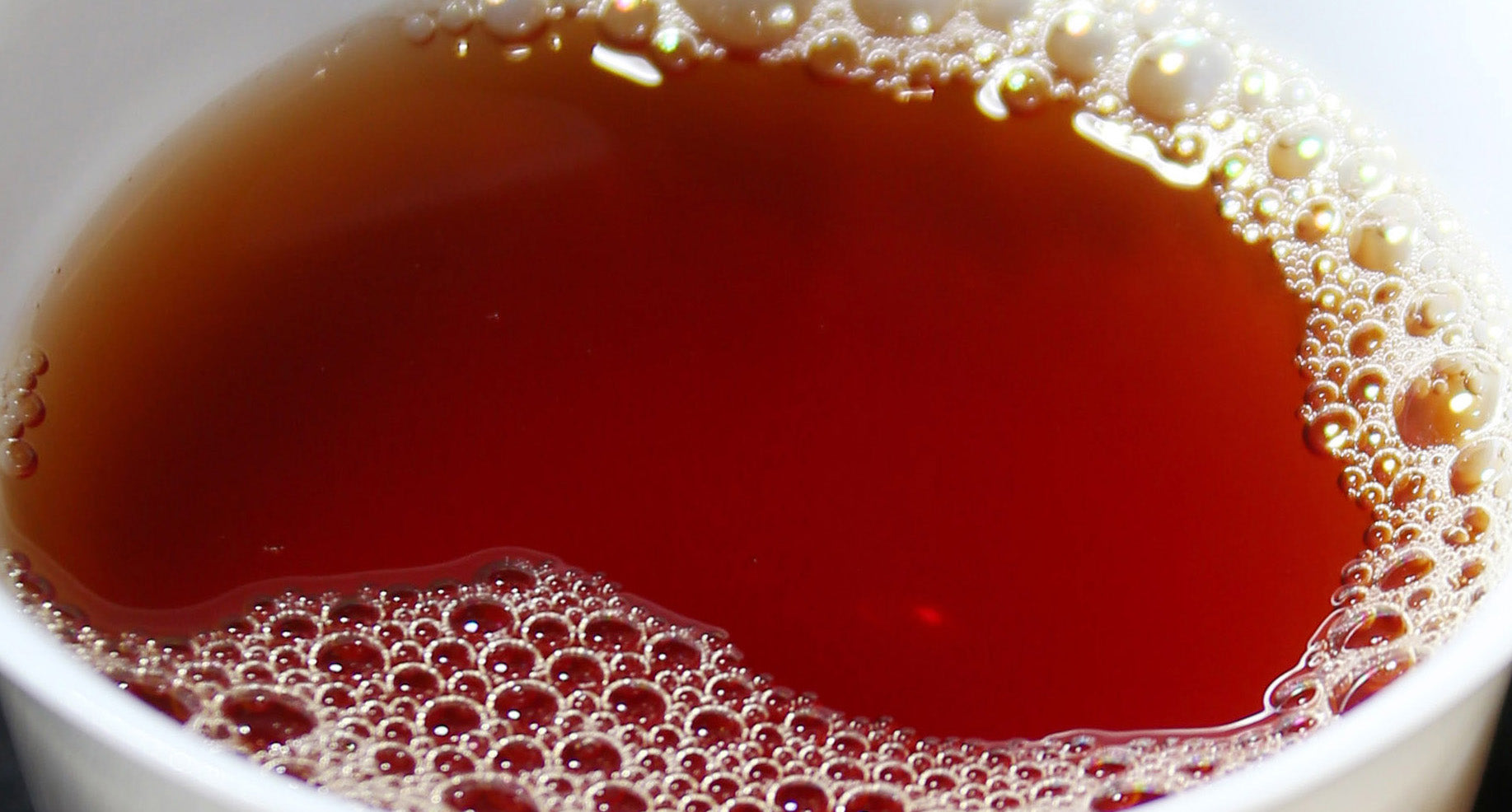
The liquor of Ye Qitong’s 1991 Da Hong Pao is amber-hued, thick and luminous, exuding the profound weight of time.
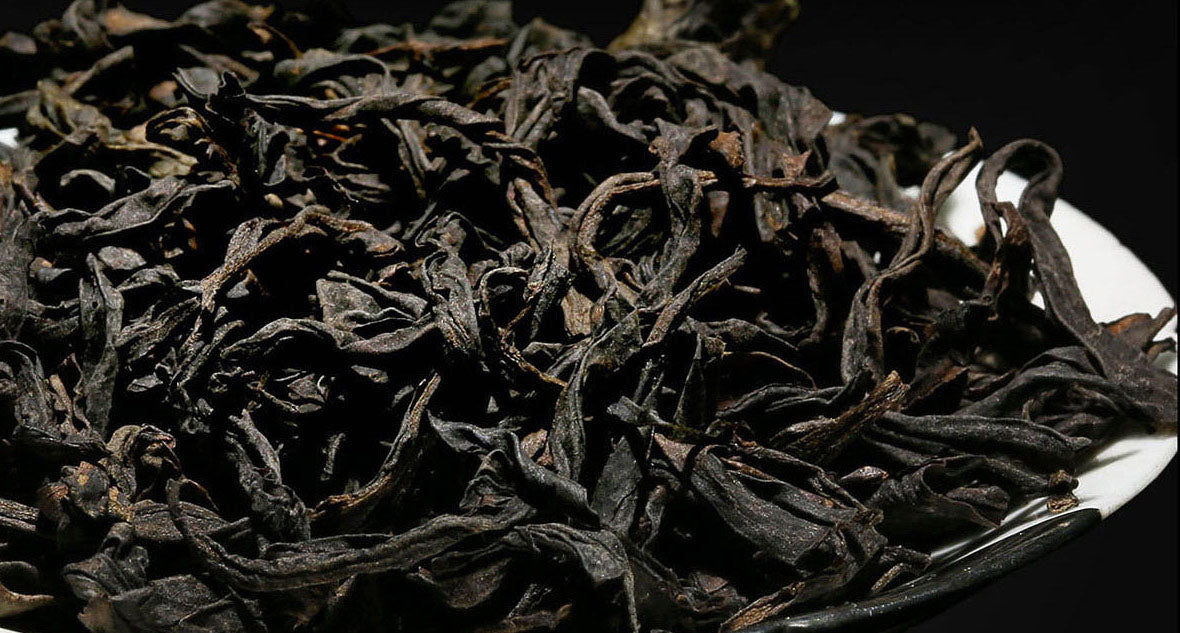
Dry tea: Dark brown with reddish brown undertones, initial aged aroma, enduring elegance.
Brewing

Brewing
Brewing Guide for Aged, Heavily Fermented & Roasted Wuyi Rock Tea
- Aged, Heavily Fermented & Roasted Wuyi Rock Tea:
Aged rock tea (stored for over 5 years, e.g., old bush Shui Xian/Narcissus, aged Da Hong Pao) undergoes flavor transformation over time — bitterness fades, woody and aged aromas become prominent, and it turns richer when simmered.
Charcoal-roasted rock tea (full-fire/high-fire) features well-integrated roasting and tea flavors; simmering it unlocks caramel and nutty notes. - Tea Leaves for Simmering: Use the leftover wet leaves after 5-6 infusions. Simmering extracts the residual charm fully, avoiding waste (wet leaves from new tea can also be simmered but with strict time control).
Note: This method is NOT suitable for other styles, especially fresh fragrance-type new rock tea (light/moderate fire) or high-aroma varieties (e.g., Huang Guanyin/Golden Guanyin).
Tea brewing utensils
- Tea brewing equipment : Glass teapot (transparent for easy observation), ceramic teapot (heat retention and aroma enhancement), electric ceramic stove (precise temperature control).
Avoid stainless steel teapots (may alter the liquor color). - Capacity : 300-500ml teapot, tea-to-water ratio approximately 1:50~1:80 (e.g., 5g tea to 300ml water).
- Auxiliary tools : tea strainer (to filter out tea leaves), tea tongs (to pick up tea leaves).
Tea brewing steps
(Suitable for aged Wuyi rock tea/heavy roasted tea)
Warm the Pot & Awaken the Tea :
Rinse the simmering vessel with boiling water. Add 5-8g dry tea (1/3 less than the brewing amount to avoid over-concentration). Dry-roast over low heat for 10-20 seconds (or shake gently) to stimulate aged and roasted aromas. This step is similar to "tea stir-frying," helping remove foreign odors.
Add water and boil :
Cold Water Method: Pour room-temperature mountain spring water or purified water into the pot. Bring to a boil over high heat, then switch to low heat and maintain a gentle simmer for 1-2 minutes. Stop when the liquor turns bright orange-red—over-simmering can cause bitterness.
Hot Water Method: Add tea to boiling water. Simmer for up to 1 minute, then turn off the heat and let it steep for 1 minute using residual heat. Ideal for beginners who prefer less bitterness.
Serving :
Strain the liquor through a tea strainer into a fairness cup and serve hot. The tea can be re-simmered 2-3 times. Shorten the simmering time to 30 seconds – 1 minute for the second round.
Key points
Water Selection :
Water is the paramount priority.
Choose Qualified purified water; never use alkaline water.
(For commercially available mineral water brands, their water sources and quality indicators vary. So-called "high-quality mineral water and mountain spring water" may cause loss of functional components and inhibition of aroma in tea.)
Temperature control to Avoid Bitterness :
Maintain a gentle simmer ("crab-eye boil" stage) throughout—never a rolling boil. This prevents over-extraction of catechins and caffeine due to high temperatures.
Flavor enhancement :
Serve the simmered tea warm. If there’s a slight bitterness when cold, reheating will make the taste smoother.
Taboo Reminder :
Those with an empty stomach or insomnia should limit strong tea. Simmered tea is highly concentrated; pair it with snacks (e.g., mung bean cake, nuts) to reduce irritation.
For zisha teapots: Only use porous coarse ceramic pots. Fine zisha teapots easily absorb flavors, and high temperatures may damage the pot.
Following these methods maximizes the tea’s traits of "rich fullness and long-lasting throat charm," making it especially suitable for seasoned tea drinkers or those who prefer a rich, mellow taste.
Core takeaways: Choose the right tea (aged/heavily roasted), control the heat (gentle slow simmer), adjust the tea amount (less dry tea, re-simmer used leaves)—you’ll brew a pot of rock tea with unique flavor.
Brewing Guide for High-Aroma, Moderate-to-Full Roasted Wuyi Rock Tea
I.Pre-Brewing Preparation
Utensils :
Main Brewer: 110ml small vermilion clay gaiwan (enhances aroma and highlights the bold rock rhyme and spicy notes).
Auxiliaries: Glass fairness cup (to observe the orange-red liquor), 50ml white porcelain tasting cups (for accurate aroma presentation).
Tools: Bamboo tea spoon (odor-free), thin-spout kettle (for water flow control).
Tea and water :
Tea: Wrap 8g dry tea in tissue paper, aerate in a cool, well-ventilated place for 30 minutes (reduces stagnant taste).
Water: Use purified water with TDS 50-100mg/L (mineral water is not recommended as it masks the rock rhyme); boiling water at 100℃ is required (to stimulate deep-layered rock rhyme and spicy notes).
II. Core Brewing Steps
Warm Ware & Rinse Tea:
Rinse all tea ware with boiling water until the temperature reaches ≥80℃ (to avoid trapping aroma), then drain thoroughly. Add 8g tea to the gaiwan, shake gently to spread evenly at the bottom. Pour boiling water from a height (10cm above the gaiwan rim), fill to the brim, cover, and steep for 5 seconds before draining completely (rinse once only to preserve spicy notes). Use the rinsing water to warm the tasting cups and enhance residual aroma.
Brewing:
Infusions 1-3: Pour boiling water from a height along the gaiwan wall, steep for 6-8 seconds (releases cinnamon aroma and awakens the tea’s inherent qualities).
Infusions 4-7: Pour boiling water from a height in a circular motion, steep for 10-12 seconds (rock rhyme blends with spicy notes, and the liquor becomes richer).
After Infusion 8: Pour boiling water from a height at a fixed point, add 5 seconds to each subsequent steep (preserves the sweet finish, with rock rhyme lingering).
Note: Drain the liquor completely within 10 seconds when serving (tilt the gaiwan at 15°) to avoid bitterness from over-steeping.
3. Key points
Avoid water temperature below 95℃ (rock rhyme is hard to release), steeping for over 15 seconds (bitterness appears), and tea ware with foreign odors (flavor contamination).
With moderate to full roasting and aroma-locking vermilion clay gaiwan, it ultimately presents the true Zheng Yan (True Cliff) character: "spicy notes without irritating the throat, rock rhyme lingering at the throat base, and a rich, smooth liquor with natural sweetness."
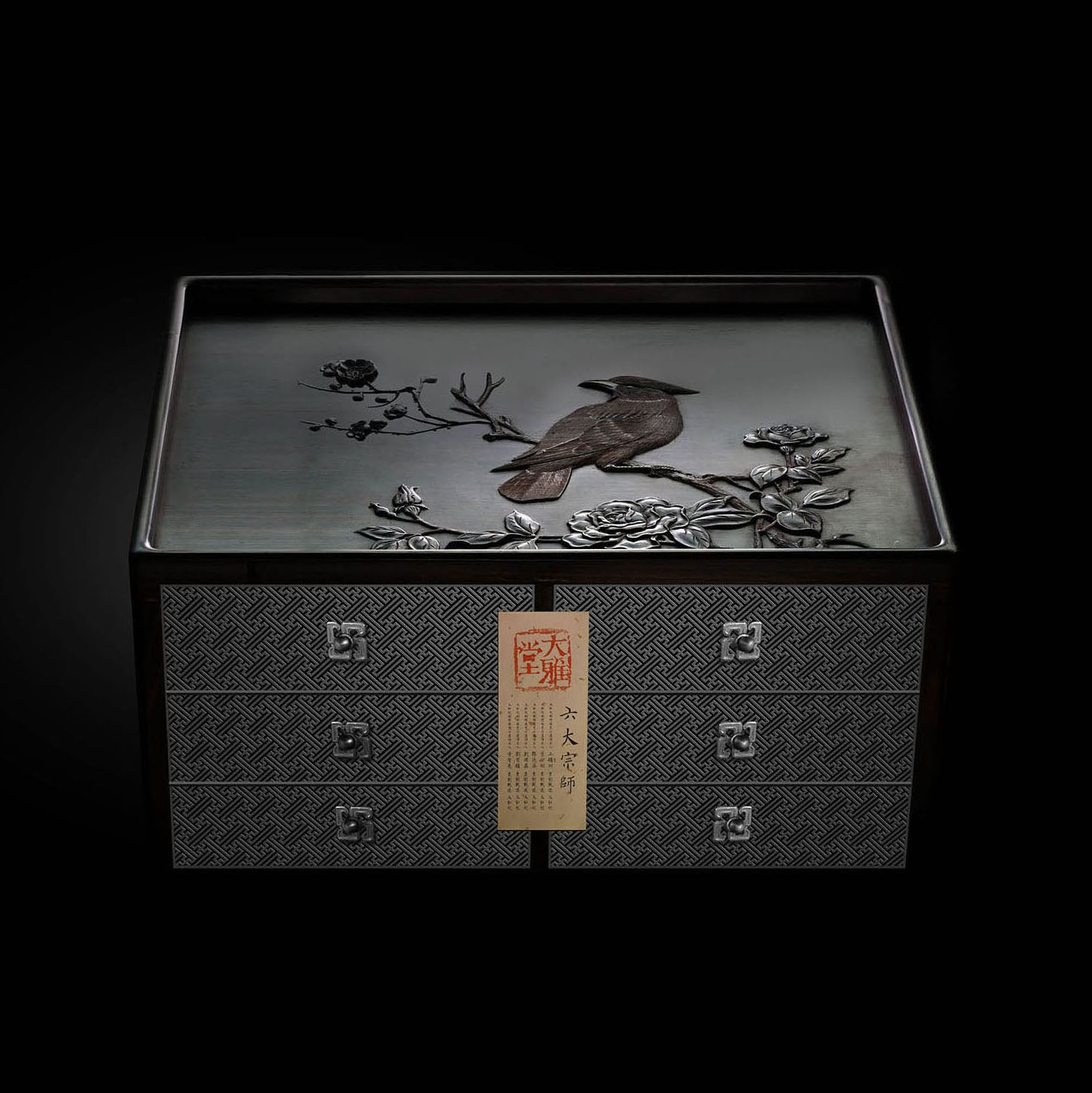
Bois de rose & Filigree Sandalwood Relief Carving & Hoopoe Perching on Branches & Wan" (Eternity) Pattern & Six-Drawer Tea Caddy.
Storage

Stable, dry, light-proof and odor-free
Da Hong Pao (a representative of Wuyi Rock Tea, semi-fermented) requires storage adjustments based on roasting intensity (light/middle/full roast).
The core principles are to prevent moisture absorption, odor contamination and oxidation—full-roast Da Hong Pao can improve in quality through proper storage.
I. General Storage Principles
Da Hong Pao is highly sensitive to temperature, humidity, light and odors, and must follow the principles of "stability, dryness, light protection and odorlessness". Specific parameters are as follows:
Temperature: 20-25℃, avoiding fluctuations of ±5℃ (to prevent oxidation or condensation leading to mold).
Humidity: 50%-60% (mold-prone above 65%, loss of activity below 45%).
Light: Complete light protection (to prevent ultraviolet rays from damaging tea polyphenols, which makes the tea liquor astringent).
Odors: Keep away from spices, cooking fumes, etc. (tea leaves are porous and prone to irreversible odor contamination).
Air Permeability: Sealed for short-term storage (within 1 year); slightly ventilated for long-term storage (full-roast tea for over 1 year) (to prevent moisture accumulation or aroma loss).
ss).
II. Classification Storage by Roasting Intensity
- Light-Roast Da Hong Pao (Prominent Orchid/Fruity Aromas)
Characteristics: Contains 7%-8% moisture. Aroma fades easily and has poor storage stability.
Storage Method: Consume within 3-6 months. Seal in aluminum foil bags and place in airtight containers, storing in a cool area (away from kitchens/balconies).
Taboo: Do not refrigerate (condensation forms during thawing, causing a stale odor). - Middle-Roast Da Hong Pao (Balanced Aroma and Taste)
Characteristics: Contains 6%-7% moisture. More stable than light-roast tea, with a storage life of 1 year.
Storage Method: Divide into 5-10g portions wrapped in rice paper, store in ceramic/tin cans (leave a 1-2mm gap). Ventilate for 3-5 minutes monthly.
Shelf Life: Best consumed within 1 year (roast aroma and rock rhyme diminish after expiration). - Full-Roast Da Hong Pao (Caramel/Woody Aromas, Rich Rock Rhyme)
Characteristics: Contains 5%-6% moisture. Stable and suitable for aging (3-5 years, developing aged/medicinal aromas).
Storage Method:
Initial stage (1-3 months): Wrap in rice paper and place in purple clay/coarse pottery jars (leave a loose 3-5mm gap). Ventilate weekly to reduce "roast heat".
Long-term storage (over 1 year): Ventilate for 5 minutes quarterly. Place unscented desiccants in high-humidity environments.
Taboo: Do not store with light/middle-roast teas (to avoid irreversible odor contamination).
III. Storage Container Selection
Aluminum foil sealed bags : Suitable for short-term storage (within 3 months) of light-roast and middle-roast teas. Features strong sealing, effectively isolating moisture and odors.
Airtight Ceramic Jars: Ideal for storing middle-roast teas for 6-12 months. Lightproof and odorless, requiring only regular ventilation.
Unglazed purple clay jar : Specifically designed for aging full-roast teas for over 1 year. Provides uniform air permeability and humidity regulation; must be deodorized before use.
Food-grade tin cans : Compatible with storing middle-roast and full-roast teas for 6-24 months. Balances sealing and air permeability while preventing oxidation, with the only drawback of higher cost.
Lidded Glass Jars: Only suitable for short-term consumption (within 1 month) of teas of all roasting intensities. Allows visual inspection of tea condition but requires additional light shielding, with average sealing performance.
IV. Common Storage Mistakes
Storing tea in the refrigerator: High humidity and mixed odors in the refrigerator, coupled with temperature differences, easily cause condensation on tea leaves leading to mold. Additionally, the tea’s aroma becomes difficult to release.
Using Ordinary Plastic Bags for Storage: Prone to absorbing plastic odors and moisture. The tea will lose its "rock texture and floral aroma" within 1-2 weeks.
Fully sealed roasted tea: Blocks the tea’s "breathing" process, leading to moisture accumulation in the container and a stale, moldy odor.
Mixing with other Tea Types: Aromas and components of different teas overlap (e.g., the aged aroma of Pu-erh masks the roast aroma of Da Hong Pao), resulting in the loss of the tea’s original flavor.
V. Quality Inspection After Storage (Mandatory Regular Check)
Look: Inspect tea leaves for white/green/black mold spots.
Smell: Identify abnormal odors such as moldy or sour smells. For slight stale odors, spread the tea out to air for 1-2 hours before re-storing.
Brewing: Taste the tea liquor—if it becomes astringent or the aroma fades, consume the tea as soon as possible.
Summary
Light-roast tea: Consume within 3-6 months (sealed tightly to retain fresh aroma).
Middle-roast tea: Balance sealing and ventilation (best consumed within 1-2 years).
Full-roast tea: Slightly ventilate for aging (suitable for 5+ years of storage).






